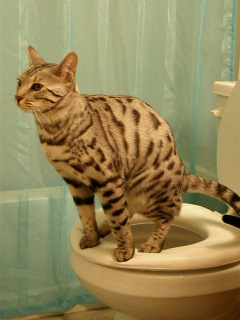Potential Issues of Flushing Cat Poop Down Your Toilet - Safeguard Your Plumbing
Potential Issues of Flushing Cat Poop Down Your Toilet - Safeguard Your Plumbing
Blog Article
Just about everyone has got their own unique way of thinking when it comes to Don’t flush cat feces down the toilet.

Introduction
As pet cat proprietors, it's important to be mindful of just how we deal with our feline pals' waste. While it might appear practical to purge pet cat poop down the bathroom, this method can have detrimental repercussions for both the environment and human health.
Environmental Impact
Purging pet cat poop introduces damaging microorganisms and bloodsuckers right into the water, posturing a considerable danger to marine communities. These impurities can negatively impact aquatic life and compromise water high quality.
Health and wellness Risks
Along with environmental problems, flushing pet cat waste can likewise present wellness dangers to human beings. Pet cat feces might have Toxoplasma gondii, a parasite that can trigger toxoplasmosis-- a potentially severe illness, especially for expectant women and people with weakened immune systems.
Alternatives to Flushing
The good news is, there are more secure and a lot more responsible methods to dispose of pet cat poop. Consider the following options:
1. Scoop and Dispose in Trash
One of the most common approach of getting rid of pet cat poop is to scoop it into a biodegradable bag and toss it in the garbage. Make certain to use a committed trash scoop and dispose of the waste immediately.
2. Use Biodegradable Litter
Choose biodegradable feline clutter made from materials such as corn or wheat. These litters are environmentally friendly and can be safely taken care of in the trash.
3. Hide in the Yard
If you have a backyard, consider hiding feline waste in an assigned location away from vegetable gardens and water resources. Make certain to dig deep sufficient to prevent contamination of groundwater.
4. Mount a Pet Waste Disposal System
Purchase a pet dog waste disposal system specifically made for cat waste. These systems make use of enzymes to break down the waste, decreasing smell and environmental impact.
Conclusion
Accountable family pet possession extends past giving food and shelter-- it likewise includes correct waste monitoring. By refraining from flushing cat poop down the toilet and choosing alternate disposal approaches, we can decrease our environmental footprint and safeguard human wellness.
Why Can’t I Flush Cat Poop?
It Spreads a Parasite
Cats are frequently infected with a parasite called toxoplasma gondii. The parasite causes an infection called toxoplasmosis. It is usually harmless to cats. The parasite only uses cat poop as a host for its eggs. Otherwise, the cat’s immune system usually keeps the infection at low enough levels to maintain its own health. But it does not stop the develop of eggs. These eggs are tiny and surprisingly tough. They may survive for a year before they begin to grow. But that’s the problem.
Our wastewater system is not designed to deal with toxoplasmosis eggs. Instead, most eggs will flush from your toilet into sewers and wastewater management plants. After the sewage is treated for many other harmful things in it, it is typically released into local rivers, lakes, or oceans. Here, the toxoplasmosis eggs can find new hosts, including starfish, crabs, otters, and many other wildlife. For many, this is a significant risk to their health. Toxoplasmosis can also end up infecting water sources that are important for agriculture, which means our deer, pigs, and sheep can get infected too.
Is There Risk to Humans?
There can be a risk to human life from flushing cat poop down the toilet. If you do so, the parasites from your cat’s poop can end up in shellfish, game animals, or livestock. If this meat is then served raw or undercooked, the people who eat it can get sick.
In fact, according to the CDC, 40 million people in the United States are infected with toxoplasma gondii. They get it from exposure to infected seafood, or from some kind of cat poop contamination, like drinking from a stream that is contaminated or touching anything that has come into contact with cat poop. That includes just cleaning a cat litter box.
Most people who get infected with these parasites will not develop any symptoms. However, for pregnant women or for those with compromised immune systems, the parasite can cause severe health problems.
How to Handle Cat Poop
The best way to handle cat poop is actually to clean the box more often. The eggs that the parasite sheds will not become active until one to five days after the cat poops. That means that if you clean daily, you’re much less likely to come into direct contact with infectious eggs.
That said, always dispose of cat poop in the garbage and not down the toilet. Wash your hands before and after you clean the litter box, and bring the bag of poop right outside to your garbage bins.
https://trenchlesssolutionsusa.com/why-cant-i-flush-cat-poop/

Do you enjoy more info about Don’t flush cat feces down the toilet? Place a review below. We will be pleased to hear your insights about this blog. Hoping that you come back again before long. Appreciated our piece? Please share it. Help another person locate it. We love reading our article about Can You Flush Cat Poo or Litter Down the Toilet?.
Maintenance Sign-Up Report this page